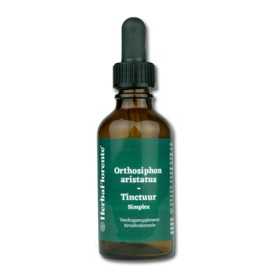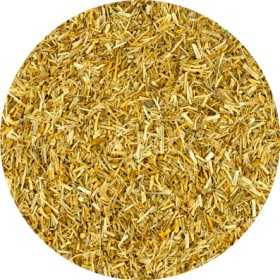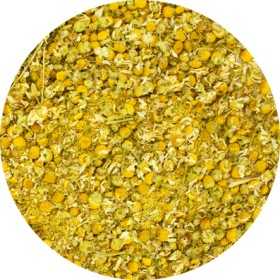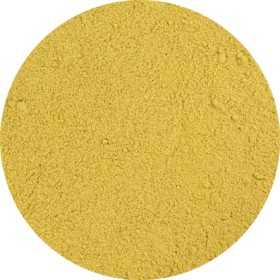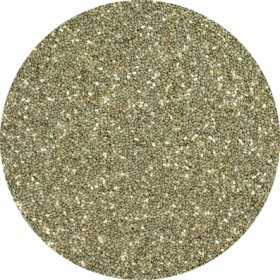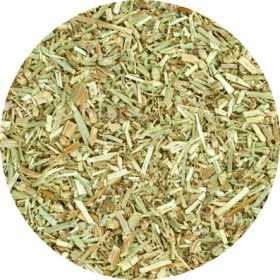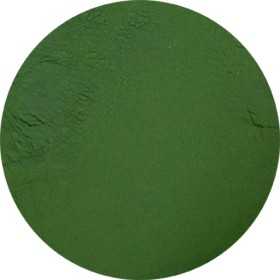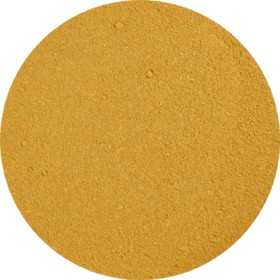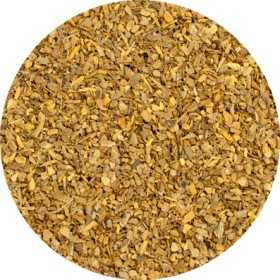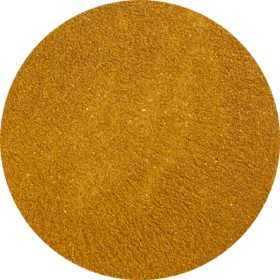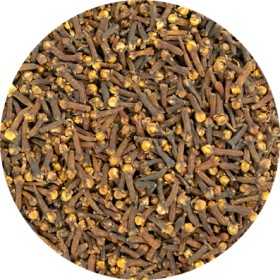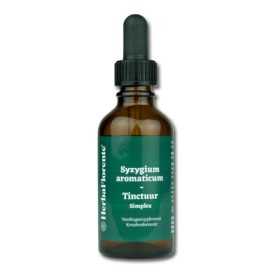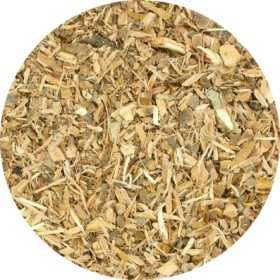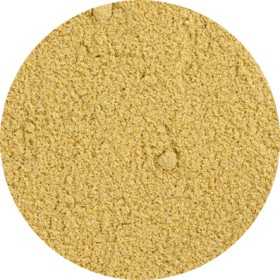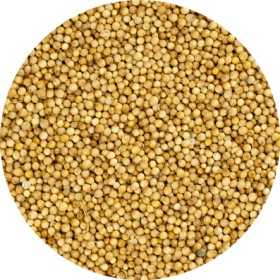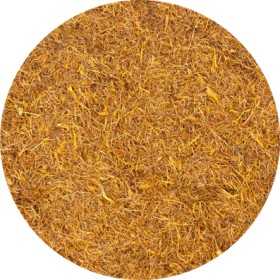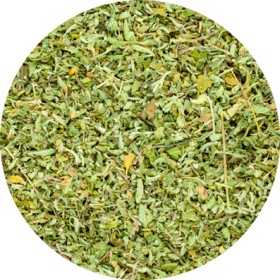List of products by brand HerbaFlorente
There are 286 products.
Cat's Claw - Uncaria tomentosa - Cut
Cat's claw (Uncaria tomentosa) is a climbing plant that is native to the Amazon region of Brazil and Peru. It is highly valued in the Peruvian Amazon and is among the protected species. This plant is often called the 'sacred herb of the rainforest' because of its significance. The name 'cat's claw' or 'cat's claw' is derived from the small claw-like thorns at the base of the leaves, which resemble a cat's claws. These claws help the vine to wrap itself around trees and climb up to a hundred meters high!
€2.20
From: €2.20
Cat's Claw Tincture - Uncaria tomentosa Tincture
Single herbal tincture made with dried bark of Uncaria tomentosa (Cat's Claw).
Although the West has only recently discovered the benefits of this herb, many cultures native to the Amazon rainforest have been using cat's claw for centuries. It is known for its ability to keep joints flexible and to support the human body's immune system. The active ingredients of cat's claw are alkaloids, tannins and various other phytochemicals. Research has shown that some of these alkaloids can support the immune system.
Although the West has only recently discovered the benefits of this herb, many cultures native to the Amazon rainforest have been using cat's claw for centuries. It is known for its ability to keep joints flexible and to support the human body's immune system. The active ingredients of cat's claw are alkaloids, tannins and various other phytochemicals. Research has shown that some of these alkaloids can support the immune system.
€9.95
Cat's whiskers Tincture - Orthosiphon aristatus Tincture
Single herbal tincture made with dried herb of Orthosiphon aristatus (Cat's whiskers).
Cat's whisker (Orthosiphon aristatus), also known as Kumis Kutjing, has played an important role in Ayurvedic medicine for centuries due to its beneficial properties in treating urinary tract infections.
This plant belongs to the Lamiaceae family and thrives mainly in tropical and subtropical regions, preferring locations such as wetlands, along rivers and swamps, especially in Southeast Asia, especially Malaysia and Java. The name "cat's whisker" is derived from the white or lilac flowers with striking, thread-like stamens, sometimes up to 3 cm long.
Cat's whisker (Orthosiphon aristatus), also known as Kumis Kutjing, has played an important role in Ayurvedic medicine for centuries due to its beneficial properties in treating urinary tract infections.
This plant belongs to the Lamiaceae family and thrives mainly in tropical and subtropical regions, preferring locations such as wetlands, along rivers and swamps, especially in Southeast Asia, especially Malaysia and Java. The name "cat's whisker" is derived from the white or lilac flowers with striking, thread-like stamens, sometimes up to 3 cm long.
€10.95
Catnip - Nepetae catariae
Wild catnip (Nepeta cataria) belongs to a genus of 250 species in the family Lamiaceae. The genus is closely related to Glechoma, Stachys and Prunella. This genus originally occurs in Europe and Asia. The stems grow in nodes and often form dense carpets on the ground. The leaves are coarsely toothed and feel soft because of the hairs. The erect stems bear small, tubular flowers in pairs that are located in the axils of the leaves.
€2.20
From: €2.20
Centaury - Centaurium erythraea
Centaury, also known by the scientific name Centaurium (synonym: Erythraea), includes about fifty species of herbaceous plants belonging to the gentian family (Gentianaceae). The genus may have been named after the centaur Chiron from Greek mythology, who was known for his knowledge of medicinal herbs and reportedly treated his wounds with this herb. An alternative explanation for the botanical name is derived from the Latin 'centum' (= one hundred) and 'aurum' (= gold).
In North America, the European centaury is sometimes cultivated as a medicinal plant and has been partly introduced as an exotic plant. The herb contains various bitter substances, glycosides, flavonoids, essential oils, valeric acid and xanthones.
In North America, the European centaury is sometimes cultivated as a medicinal plant and has been partly introduced as an exotic plant. The herb contains various bitter substances, glycosides, flavonoids, essential oils, valeric acid and xanthones.
€2.50
From: €2.50
Chamomile (Flower) - Matricaria recutita, Chamomillae europ. - Whole
True chamomile, also known as Matricaria chamomilla or Matricaria recutita, is native throughout Europe and widely cultivated in countries such as Hungary and Eastern Europe. The ancient Egyptians revered chamomile as the flower of the sun god Ra. The herb is known for its supportive effect on the immune system, soothing effect on the respiratory tract and promoting digestion. Additionally, chamomile is often used as a natural sedative and to promote restful sleep.
€2.95
From: €2.95
Chamomile - Matricaria recutita, Chamomillae europ.
True chamomile, also known as Matricaria chamomilla or Matricaria recutita, is native throughout Europe and widely cultivated in countries such as Hungary and Eastern Europe. The ancient Egyptians revered chamomile as the flower of the sun god Ra. The herb is known for its supportive effect on the immune system, soothing effect on the respiratory tract and promoting digestion. Additionally, chamomile is often used as a natural sedative and to promote restful sleep.
€3.00
From: €3.00
Chamomile Tincture - Matricaria recutita Tincture
Single herbal tincture made with dried flower of Matricaria recutita (True Chamomile).
True chamomile, also known as Matricaria chamomilla or Matricaria recutita, is native throughout Europe and widely cultivated in countries such as Hungary and Eastern Europe. The ancient Egyptians revered chamomile as the flower of the sun god Ra. The herb is known for its supportive effect on the immune system, soothing effect on the respiratory tract and promoting digestion. Additionally, chamomile is often used as a natural sedative and to promote restful sleep.
True chamomile, also known as Matricaria chamomilla or Matricaria recutita, is native throughout Europe and widely cultivated in countries such as Hungary and Eastern Europe. The ancient Egyptians revered chamomile as the flower of the sun god Ra. The herb is known for its supportive effect on the immune system, soothing effect on the respiratory tract and promoting digestion. Additionally, chamomile is often used as a natural sedative and to promote restful sleep.
€11.95
Chia seeds - Salviae Sem. Hispanica nigri albi
Chia, also known as Salvia hispanica, is a plant from the Lamiaceae family, originally from central and southern Mexico and Guatemala. The Aztecs cultivated this plant even before Columbus discovered America, and chia seeds were used as currency to the rulers. Today, chia is still prized in Mexico and Guatemala; the ground seeds are used in dishes, while whole seeds are often added to nutritious drinks.
The main purpose of growing chia is for its seeds, which are rich in omega-3 fatty acids. About 25-30% of the seed contains vegetable oil, including alpha-linolenic acid (ALA). Chia seeds are small and oval, about 1 mm in diameter, and have a color palette of brown, gray-black and white.
The main purpose of growing chia is for its seeds, which are rich in omega-3 fatty acids. About 25-30% of the seed contains vegetable oil, including alpha-linolenic acid (ALA). Chia seeds are small and oval, about 1 mm in diameter, and have a color palette of brown, gray-black and white.
€2.00
From: €2.00
Chicory (Herb) - Cichorium Intybus
Chicory (Cichorium) belongs to the composite family (Compositae or Asteraceae) and includes well-known vegetables such as chicory and endive. It is mainly consumed for health reasons.
Since the late years of the twentieth century, chicory roots have been cultivated not only for chicory, but also for the production of inulin and sweeteners, especially fructose. Both inulin (a dietary fiber) and fructose are widely used in the food industry.
Roasted chicory root is used as a coffee substitute or as an ingredient in coffee brewing. In the past, this was done out of necessity, such as during the Napoleonic blockade during the French occupation.
Since the late years of the twentieth century, chicory roots have been cultivated not only for chicory, but also for the production of inulin and sweeteners, especially fructose. Both inulin (a dietary fiber) and fructose are widely used in the food industry.
Roasted chicory root is used as a coffee substitute or as an ingredient in coffee brewing. In the past, this was done out of necessity, such as during the Napoleonic blockade during the French occupation.
€2.00
From: €2.00
Chicory (Root) - Cichorium Intybus - Cut
Chicory (Cichorium) belongs to the composite family (Compositae or Asteraceae) and includes well-known vegetables such as chicory and endive. It is mainly consumed for health reasons.
Since the late years of the twentieth century, chicory roots have been cultivated not only for chicory, but also for the production of inulin and sweeteners, especially fructose. Both inulin (a dietary fiber) and fructose are widely used in the food industry.
Roasted chicory root is used as a coffee substitute or as an ingredient in coffee brewing. In the past, this was done out of necessity, such as during the Napoleonic blockade during the French occupation.
Since the late years of the twentieth century, chicory roots have been cultivated not only for chicory, but also for the production of inulin and sweeteners, especially fructose. Both inulin (a dietary fiber) and fructose are widely used in the food industry.
Roasted chicory root is used as a coffee substitute or as an ingredient in coffee brewing. In the past, this was done out of necessity, such as during the Napoleonic blockade during the French occupation.
€2.00
From: €2.00
Chlorella - Chlorella
Chlorella, a single-celled green algae belonging to the green algae family, thrives in lakes and rivers of Southeast Asia. This microscopic organism is a veritable treasure trove of nutrients, including proteins, vitamins, trace elements and omega-3 fatty acids.
Its versatility is reflected in supporting the immune system and promoting liver detoxification. Chlorella also contributes to healthy digestion and supports normal intestinal function. The name 'chlorella' has its origins in the Greek words 'chloros' and 'ella', which mean 'green' and 'small' respectively.
Its versatility is reflected in supporting the immune system and promoting liver detoxification. Chlorella also contributes to healthy digestion and supports normal intestinal function. The name 'chlorella' has its origins in the Greek words 'chloros' and 'ella', which mean 'green' and 'small' respectively.
€4.60
From: €4.60
Cinnamon - Cinnamomi ceylon
Cinnamon (Cinnamomum) has been known for centuries for its many uses. It is extracted from the bark of the Cinnamomum cassia tree, where part of the bark is carefully cut loose and the rough outer surface is removed with a knife. The well-known cinnamon sticks or cinnamon powder are made from the inside of the bark. Cinnamon has been valued for centuries, both in culinary and herbalist circles.
This herb has been used in Asian cultures for centuries for its versatile uses. The wonderful aroma of cinnamon is determined by volatile oils, of which cinnamaldehyde is the most common. In addition, cinnamon also contains substances such as eugenol, coumarins, tannins, OPCs and terpenes.
This herb has been used in Asian cultures for centuries for its versatile uses. The wonderful aroma of cinnamon is determined by volatile oils, of which cinnamaldehyde is the most common. In addition, cinnamon also contains substances such as eugenol, coumarins, tannins, OPCs and terpenes.
€2.95
From: €2.95
Cinnamon - Cinnamomi ceylon - Cut
Cinnamon (Cinnamomum) has been known for centuries for its many uses. It is extracted from the bark of the Cinnamomum verum tree, where part of the bark is carefully cut loose and the rough outer surface is removed with a knife. The well-known cinnamon sticks or cinnamon powder are made from the inside of the bark. Cinnamon has been valued for centuries, both in culinary and herbalist circles.
This herb has been used in Asian cultures for centuries for its versatile uses. The wonderful aroma of cinnamon is determined by volatile oils, of which cinnamaldehyde is the most common. In addition, cinnamon also contains substances such as eugenol, coumarins, tannins, OPCs and terpenes.
This herb has been used in Asian cultures for centuries for its versatile uses. The wonderful aroma of cinnamon is determined by volatile oils, of which cinnamaldehyde is the most common. In addition, cinnamon also contains substances such as eugenol, coumarins, tannins, OPCs and terpenes.
€3.00
From: €3.00
Citrus Blend Herbal Tea
Herbal tea composed of various herbs
Delicious for every moment
Delicious for every moment
€3.95
Clove - Syzygium aromaticum
Clove (Syzygium aromaticum) is the dried, fragrant flower bud of the clove tree. The main active ingredient is eugenol, which also promotes the antioxidant properties of cloves. Clove is known for its antioxidant effect and supports healthy digestion. In addition, it improves blood circulation and soothes the throat.
€3.10
From: €3.10
Clove - Syzygium aromaticum - Whole
Clove (Syzygium aromaticum) is the dried, fragrant flower bud of the clove tree. The main active ingredient is eugenol, which also promotes the antioxidant properties of cloves. Clove is known for its antioxidant effect and supports healthy digestion. In addition, it improves blood circulation and soothes the throat.
€3.00
From: €3.00
Clove Tincture - Syzygium aromaticum Tincture
Single herbal tincture made with dried flower of Syzygium aromaticum (Clove).
Clove (Syzygium aromaticum) is the dried, fragrant flower bud of the clove tree. The main active ingredient is eugenol, which also promotes the antioxidant properties of cloves. Clove is known for its antioxidant effect and supports healthy digestion. In addition, it improves blood circulation and soothes the throat.
Clove (Syzygium aromaticum) is the dried, fragrant flower bud of the clove tree. The main active ingredient is eugenol, which also promotes the antioxidant properties of cloves. Clove is known for its antioxidant effect and supports healthy digestion. In addition, it improves blood circulation and soothes the throat.
€10.95
Comfrey Tincture - Symphytum officinalis Tincture
Single herbal tincture made with dried root of Symphytum officinalis (Comfrey).
The common comfrey (Symphytum officinale) is common in the Netherlands and Belgium. Comfrey belongs to the rough-leaved family (Boraginaceae). It is a genus of plants consisting mainly of perennial herbs, not shrubs or trees. The calyx of the flower is cut by a quarter or completely, while the leaves are elongated to lanceolate and scattered.
Comfrey is traditionally used for ointments, wraps and compresses that help with broken bones, sprains and bruises.
The common comfrey (Symphytum officinale) is common in the Netherlands and Belgium. Comfrey belongs to the rough-leaved family (Boraginaceae). It is a genus of plants consisting mainly of perennial herbs, not shrubs or trees. The calyx of the flower is cut by a quarter or completely, while the leaves are elongated to lanceolate and scattered.
Comfrey is traditionally used for ointments, wraps and compresses that help with broken bones, sprains and bruises.
€12.95
copy of Witch Hazel (Bark) - Hamamelis virginiana
The American witch hazel (Hamamelis virginiana) is a shrub belonging to the family Hamamelidaceae, native to North America from Nova Scotia to Minnesota, and from southern and central Florida to eastern Texas.
The shrub can reach a height of 6 to sometimes even 10 meters, with a bushy growth thanks to the many branches that arise just above the ground. The bark is light brown, smooth but somewhat flaky, and shows a reddish-purple color on the inside.
Blooming from September through October, the flowers of the American witch hazel display clusters of 4 stamens. They usually range from pale yellow to bright yellow, although orange or red hues also occur. The petals are ribbon-shaped and measure 10-20 mm in length.
The shrub can reach a height of 6 to sometimes even 10 meters, with a bushy growth thanks to the many branches that arise just above the ground. The bark is light brown, smooth but somewhat flaky, and shows a reddish-purple color on the inside.
Blooming from September through October, the flowers of the American witch hazel display clusters of 4 stamens. They usually range from pale yellow to bright yellow, although orange or red hues also occur. The petals are ribbon-shaped and measure 10-20 mm in length.
€5.20
From: €5.20
Coriander - Coriandrum sativum
Coriander seeds have been used for thousands of years to support digestion and intestinal health, and this tradition continues to this day. People who want to strengthen their immune system prefer coriander seeds. In addition, coriander seed has a beneficial effect on the heart and nervous system.
Coriander is an herb rich in valuable substances. Both the leaves and seeds contain vitamins A, C, K and folic acid, as well as minerals such as iron, manganese, potassium, magnesium and calcium. The seeds are especially rich in essential oils such as linalool, camphor, gamma terpinene and geranyl acetate. The seeds are the main source of nutrients.
Coriander is an herb rich in valuable substances. Both the leaves and seeds contain vitamins A, C, K and folic acid, as well as minerals such as iron, manganese, potassium, magnesium and calcium. The seeds are especially rich in essential oils such as linalool, camphor, gamma terpinene and geranyl acetate. The seeds are the main source of nutrients.
€2.00
From: €2.00
Coriander - Coriandrum sativum - Whole
Coriander seeds have been used for thousands of years to support digestion and intestinal health, and this tradition continues to this day. People who want to strengthen their immune system prefer coriander seeds. In addition, coriander seed has a beneficial effect on the heart and nervous system.
Coriander is an herb rich in valuable substances. Both the leaves and seeds contain vitamins A, C, K and folic acid, as well as minerals such as iron, manganese, potassium, magnesium and calcium. The seeds are especially rich in essential oils such as linalool, camphor, gamma terpinene and geranyl acetate. The seeds are the main source of nutrients.
Coriander is an herb rich in valuable substances. Both the leaves and seeds contain vitamins A, C, K and folic acid, as well as minerals such as iron, manganese, potassium, magnesium and calcium. The seeds are especially rich in essential oils such as linalool, camphor, gamma terpinene and geranyl acetate. The seeds are the main source of nutrients.
€2.00
From: €2.00
Corn Silk - Zea mays Conc.
Dried corn silk, also called stigmas, are used in herbal medicine. When fresh, these hairs are green in color, but once dried they turn dark brown to black.
Corn silk, also known as corn beard, can have beneficial effects on fluid balance, bladder inflammation (soothing) and irritation of the urinary tract (soothing).
Corn silk, also known as corn beard, can have beneficial effects on fluid balance, bladder inflammation (soothing) and irritation of the urinary tract (soothing).
€2.00
From: €2.00
Damiana - Damianae mex. (Turnera diffusa) - Cut
Damiana (Turnera diffusa) is a shrub native to southern Texas in the United States, as well as Central America, Mexico, South America and the Caribbean. It belongs to the Passifloraceae family and has been used by the Mayan Indians for centuries for its known effects on libido. Both men and women benefit from the libido-supporting properties of damiana, which is also known for its stress-reducing effect.
In Mexico, women often prepare tea from the fragrant leaves of the damiana shrub or smoke them to stimulate their feelings of pleasure. Damiana leaf contains several active substances, including beta-sitosterol, arbutin and alkaloids.
In Mexico, women often prepare tea from the fragrant leaves of the damiana shrub or smoke them to stimulate their feelings of pleasure. Damiana leaf contains several active substances, including beta-sitosterol, arbutin and alkaloids.
€4.60
From: €4.60
















